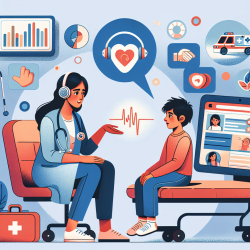Unlock the Secrets to Effective Communication in ICUs: A Must-Read for Practitioners!
Effective communication in the Intensive Care Unit (ICU) is critical for patient outcomes, especially for those with advanced airways. As practitioners, understanding the barriers and facilitators to using augmentative and alternative communication (AAC) and voice restorative devices can significantly enhance patient care. A recent scoping review titled "Barriers to and facilitators for use of augmentative and alternative communication and voice restorative devices in the adult intensive care unit: a scoping review protocol" sheds light on these crucial aspects. Let's delve into the key findings and how they can be implemented in practice.
Understanding the Barriers
The review identified several barriers to the utilization of AAC and voice restorative devices in the ICU. These barriers were categorized using the Theoretical Domains Framework (TDF), which includes behavioral and contextual determinants. Here are some of the key barriers:
- Device Characteristics: Complexity and usability issues of AAC devices often deter their use. Devices that are difficult to operate or require extensive training are less likely to be adopted.
- Clinical Condition of the Patient: Patients' physical and cognitive states can significantly impact the effectiveness of communication strategies. For instance, severe illness or sedation can hinder the use of AAC devices.
- Staff Constraints: Limited time and training among ICU staff are major barriers. Staff may not have the time to learn and implement these communication strategies effectively.
Facilitators for Effective Communication
On the flip side, the review also identified facilitators that can enhance the use of AAC and voice restorative devices:
- Ease of Use: Devices that are user-friendly and require minimal training are more likely to be adopted. Simplicity in design can go a long way in ensuring consistent use.
- Staff Training: Comprehensive training programs for ICU staff can significantly improve the utilization of these devices. Training should include not only the technical aspects but also the importance of effective communication.
- Patient-Centered Approaches: Tailoring communication strategies to meet individual patient needs can enhance their effectiveness. This includes considering the patient's physical and cognitive abilities.
Implementing the Findings
As practitioners, it is crucial to integrate these findings into everyday practice to improve patient outcomes. Here are some actionable steps:
- Invest in Training: Ensure that all ICU staff receive comprehensive training on the use of AAC and voice restorative devices. This training should be ongoing and include practical sessions.
- Choose User-Friendly Devices: Opt for AAC devices that are easy to use and require minimal training. This can significantly enhance their adoption and effectiveness.
- Patient-Centered Care: Tailor communication strategies to meet the specific needs of each patient. Regularly assess the patient's condition and adjust the communication approach accordingly.
Encouraging Further Research
While the scoping review provides valuable insights, there is always room for further research. Practitioners are encouraged to explore additional studies and contribute to the growing body of evidence. Understanding the nuances of communication barriers and facilitators can lead to more targeted interventions and better patient outcomes.
To read the original research paper, please follow this link: Barriers to and facilitators for use of augmentative and alternative communication and voice restorative devices in the adult intensive care unit: a scoping review protocol.










